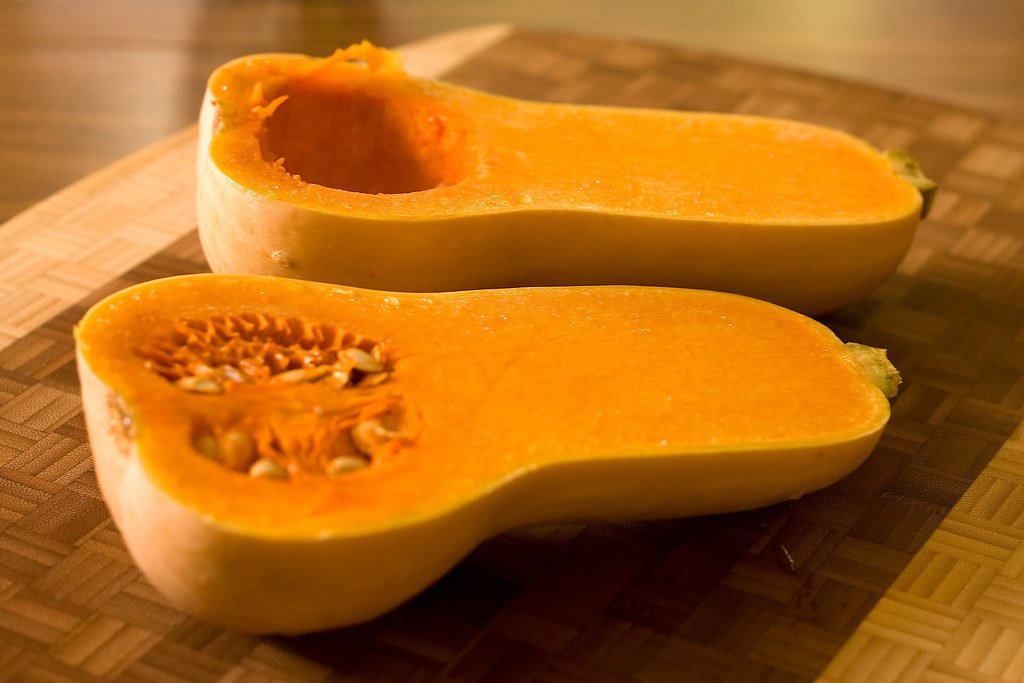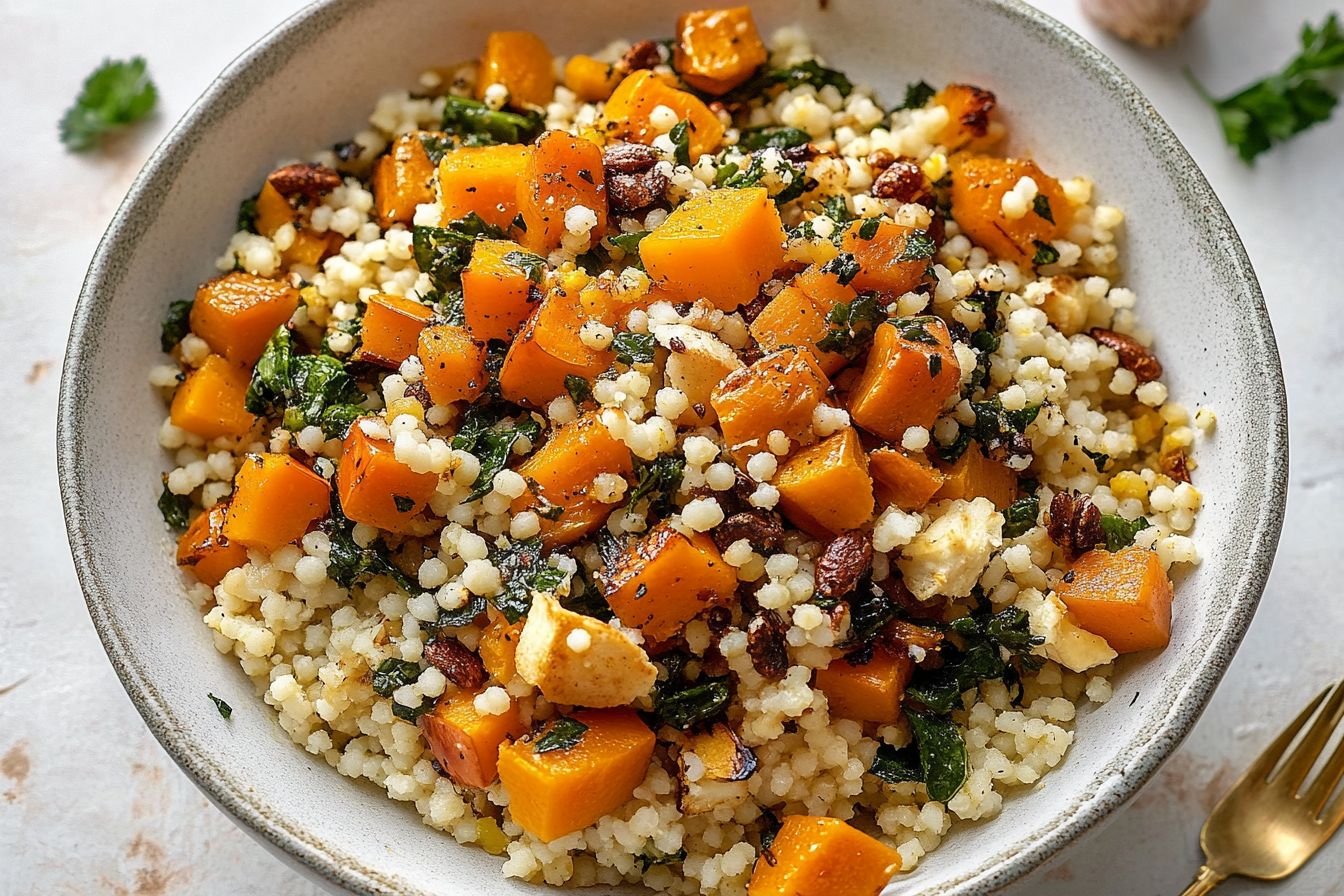Couscous with butternut squash creates a delightful mix of flavors and textures that’s perfect for any meal. This dish combines the sweet earthiness of butternut squash, the hearty protein of chickpeas, and the vibrant crunch of kale to make a satisfying and nutritious meal. I can craft a dish that shines on any table with just a few simple ingredients like olive oil, garlic powder, goat cheese, and maple vinaigrette.
As the seasons change, butternut squash becomes a staple in my kitchen, and pairing it with couscous feels both comforting and adventurous. The nuanced flavors from smoked paprika and nutmeg draw me in, while the pepitas add a delightful crunch that elevates the entire experience.
History of Pearl Couscous
Pearl couscous, also known as Israeli couscous, differs slightly from traditional couscous. It is larger, rounder, and often toasted, giving it a nutty flavor.
This form of couscous emerged in Israel in the 1950s. People aimed to create a pasta-like product that would serve as a versatile food option.
Culinary traditions across the Mediterranean and Middle East incorporated pearl couscous into various dishes. It gained popularity beyond its origins, becoming a favorite in many kitchens worldwide.
Today, I like using pearl couscous in salads, soups, and side dishes. Its unique texture and flavor elevate any meal, making it a delightful addition to my cooking repertoire.

Ingredients:
- 3 cups of cubed butternut squash
- 1 (15-ounce) can of drained and rinsed chickpeas
- 2 tbsp of olive oil
- Salt and black pepper to taste
- 1 tsp of smoked paprika
- 1 tsp of garlic powder
- 1 ½ cups of cooked pearl couscous
- 6 cups of chopped kale
- 4 ounces of crumbled goat cheese
- ¼ cup of roasted and salted pepitas
Maple vinaigrette:
- ¼ cup of apple cider vinegar
- 2 tbsp of maple syrup
- 1 of finely minced garlic clove
- ⅛ tsp of freshly ground nutmeg
- Salt and black pepper to taste
- Pinch of red pepper flakes
- ½ cup of extra virgin olive oil
How to make couscous with butternut squash?
- Preheat your oven to 425°F. Toss butternut squash and chickpeas with olive oil, smoked paprika, salt, pepper, and garlic powder on a baking sheet. Roast for 15 minutes, flip and roast for another 10-15 minutes until tender.
- While the vegetables roast, prepare the couscous and dressing. Massage kale with a portion of the maple vinaigrette in a large bowl.
- Once the couscous is cooked, toss it with some of the dressing. Add the couscous and roasted vegetables to the kale bowl, along with goat cheese and pepitas.
- Drizzle with the remaining dressing and toss to combine. Serve immediately.
- To make the maple vinaigrette, whisk together maple syrup, vinegar, nutmeg, garlic, salt, pepper, and crushed red pepper flakes. Gradually whisk in olive oil until emulsified.
Serving Suggestions
Pairing with Drinks
When serving this dish, I find matching the right drink enhances the meal. A light white wine, like Sauvignon Blanc or Pinot Grigio, balances the sweetness of the squash—these wines’ acidity cuts through the dish, creating harmony.
For a non-alcoholic option, I recommend a refreshing herbal tea, such as mint or chamomile. The mild flavors complement the couscous without overwhelming it. Alternatively, sparkling water with a splash of lemon adds a zesty touch that cleanses the palate.
Garnishing Tips
To add a flourish to my couscous dish, I often choose thoughtful garnishes. Fresh herbs like parsley or cilantro lend brightness and elevate flavors. I chop them finely and sprinkle them generously before serving.
Nuts such as toasted almonds or pine nuts add a delightful crunch. They contrast well with the soft texture of the butternut squash.
Additionally, a drizzle of olive oil or a squeeze of lemon brightens the presentation. I might even consider adding pomegranate seeds for a pop of color and sweetness. Each garnish not only enhances appearance but also enriches the overall taste experience.
Storage and Reheating
Refrigeration
- Store in the refrigerator for up to 3-5 days.
- Make sure the lid is sealed tightly to avoid moisture loss.
Freezing
- To freeze, let it cool completely.
- Portion it out into freezer-safe containers or bags.
- Label with the date to track freshness. It can last up to 3 months in the freezer.
Reheating
- I recommend thawing if it’s frozen.
- Microwave: Heat in short bursts, stirring between intervals.
- Stovetop: Add a splash of broth or water to a pan, then heat over medium. Stir until warmed through.
Tips
- Avoid reheating multiple times to maintain texture and flavor.
- Add fresh herbs or a drizzle of olive oil after reheating for extra flavor.
Common Mistakes to Avoid
- Not precooking the squash: Roasting or sautéing the squash ensures it becomes tender and flavorful. Skipping this step leads to crunchy pieces that can overpower the dish.
- Overcooking the couscous: Couscous cooks quickly. I find that letting it steam for a few minutes off the heat is best, as overcooking can turn it mushy.
- Skipping seasoning: Adding seasonings enhances the dish’s flavor. I always use salt, pepper, and often some spices like cumin or coriander for depth.
- Not fluffing the couscous: After it cooks, I use a fork to fluff the couscous. This step prevents it from clumping together.
- Ignoring texture: Balancing textures makes the dish appealing. I try to mix crunchy nuts or seeds with the soft squash and tender couscous.
Conclusion
Couscous with butternut squash is a delightful dish that combines flavors and textures beautifully. The nutty taste of couscous complements the sweetness of butternut squash perfectly.
I find that preparing this dish is simple and rewarding. The vibrant colors make it visually appealing, while the ingredients are healthy and filling.
This recipe offers versatility. You can easily customize it with additional vegetables, nuts, or seeds for extra crunch.
In short, whether for a quick weeknight dinner or a special occasion, couscous with butternut squash never disappoints. I enjoy serving it to family and friends; it always garners positive feedback.
Did you know? This wonderful dish pairs nicely with Lebanese meat rolls.
Get the recipe now (by clicking the image below):





